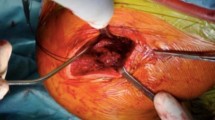Abstract
Purpose
To compare outcomes of acromioclavicular (AC) joint reconstruction with ligament augmentation and reconstruction system (LARS) ligament in professional and non-professional athletes at 2-year minimum follow-up.
Methods
Forty-three patients (men; mean age 30, range 19–54 years) with Rockwood type III to V chronic AC joint dislocations underwent AC joint reconstruction with LARS ligament and standardized rehabilitation. Patients were divided into two groups: professionals (22) and non-professionals (21). Clinical and radiological evaluations were performed preoperatively, at 3- and 24-month follow-up.
Results
All clinical (Oxford and Constant) scores and patient satisfaction improved significantly from preoperative to follow-up intervals (p < 0.00001). However, professionals showed nonsignificant improvements from 3- to 24-month follow-up in Constant. Although groups differed preoperatively in Constant (p = 0.037), they were not different in preoperative-to-postoperative differences in clinical scores, postoperative final satisfaction and median time to return to unrestricted activity [4 (interquartiler range 3–5) months to return to full sport in professionals]. Follow-up radiographs revealed an AC joint ratio (clavicle inferior-to-superior translation as ratio of AC joint height) of 0.09 and 0.16 in 8/22 professionals, 0.19 and 0.31 in 9/21 non-professionals, 0.14 and 0.24 in 17/43 overall patients at 3- and 24-month follow-up, respectively. Slight loss of reduction (0.25 < AC joint ratio < 0.50): 21 %. There were no significant clinical–radiographic correlations. Complication: one coracoid fracture at follow-up and one wound infection.
Conclusions
AC joint reconstruction with LARS ligament did not reveal differences in clinical outcomes between groups, with 2 % of failures (re-dislocations) at 2-year minimum follow-up. Superior radiological outcomes in professionals were not correlated to clinical results.
Level of evidence
Therapeutic study–prospective comparative study, Level II.


Similar content being viewed by others
References
Bankes MJ, Crossman JE, Emery RJ (1998) A standard method of shoulder strength measurement for the Constant score with a spring balance. J Shoulder Elbow Surg 7(2):116–121
Clayton RA, Court-Brown CM (2008) The epidemiology of musculoskeletal tendinous and ligamentous injuries. Injury 39(12):1338–1344
Collins DN (2009) Disorders of the acromioclavicular joint. In: Rockwood CA, Matsen FA (eds) The shoulder, vol 1. 4th edn. Saunders-Elsevier, pp 453–526
Dawson J, Fitzpatrick R, Carr A (1999) The assessment of shoulder instability. The development and validation of a questionnaire. J Bone Joint Surg Br 81(3):420–426
Dragoo JL, Braun HJ, Bartlinski SE, Harris AH (2012) Acromioclavicular joint injuries in National Collegiate Athletic Association football: data from the 2004–2005 through 2008–2009 National Collegiate Athletic Association Injury Surveillance System. Am J Sports Med 40(9):2066–2071
Fauci F, Merolla G, Paladini P, Campi F, Porcellini G (2013) Surgical treatment of chronic acromioclavicular dislocation with biologic graft vs synthetic ligament: a prospective randomized comparative study. J Orthop Traumatol 14(4):283–290
Fialka C, Michlits W, Stampfl P, Oberleitner G, Funovic P, Schmidt W, Aharinejad A, Vécsel V (2005) Biomedical analysis of different operative techniques for complete acromioclavicular joint disruptions. Osteo Trauma Care 13(3):154–159
Flint JH, Wade AM, Giuliani J, Rue JP (2014) Defining the terms acute and chronic in orthopaedic sports injuries: a systematic review. Am J Sports Med 42(1):235–241
Fraschini G, Ciampi P, Scotti C, Ballis R, Peretti GM (2010) Surgical treatment of chronic acromioclavicular dislocation: comparison between two surgical procedures for anatomic reconstruction. Injury 41(11):1103–1106
Giannotti S, Dell’osso G, Bugelli G, Cazzella N, Guido G (2013) Surgical treatment of acromioclavicular dislocation with LARS artificial ligament. Eur J Orthop Surg Traumatol 23(8):873–876
Lu N, Zhu L, Ye T, Chen A, Jiang X, Zhang Z, Zhu Q, Guo Q, Yang D (2013) Evaluation of the coracoclavicular reconstruction using LARS artificial ligament in acute acromioclavicular joint dislocation. Knee Surg Sports Traumatol Arthrosc. doi:10.1007/s00167-013-2582-0
Rios CG, Arciero RA, Mazzocca AD (2007) Anatomy of the clavicle and coracoid process for reconstruction of the coracoclavicular ligaments. Am J Sports Med 35(5):811–817
Rolf O, Hann von Weyhern A, Ewers A, Boehm TD, Gohlke F (2008) Acromioclavicular dislocation Rockwood III–V: results of early versus delayed surgical treatment. Arch Orthop Trauma Surg 128(10):1153–1157
Simovitch R, Sanders B, Ozbaydar M, Lavery K, Warner JJ (2009) Acromioclavicular joint injuries: diagnosis and management. J Am Acad Orthop Surg 17(4):207–219
Tauber M, Gordon K, Koller H, Fox M, Resch H (2009) Semitendinosus tendon graft versus a modified Weaver-Dunn procedure for acromioclavicular joint reconstruction in chronic cases: a prospective comparative study. Am J Sports Med 37(1):181–190
Trieb K, Blahovec H, Brand G, Sabeti M, Dominkus M, Kotz R (2004) In vivo and in vitro cellular ingrowth into a new generation of artificial ligaments. Eur Surg Res 36(3):148–151
Weinstein DM, McCann PD, McIlveen SJ, Flatow EL, Bigliani LU (1995) Surgical treatment of complete acromioclavicular dislocations. Am J Sports Med 23(3):324–331
Acknowledgments
The authors thank Linda Hallam, Federico Raggi, MD and Tommaso Roberti di Sarsina, MD for their help in data management.
Conflict of interest
The authors declare that they have no conflict of interest.
Author information
Authors and Affiliations
Corresponding author
Electronic supplementary material
Below is the link to the electronic supplementary material.
Rights and permissions
About this article
Cite this article
Marcheggiani Muccioli, G.M., Manning, C., Wright, P. et al. Acromioclavicular joint reconstruction with the LARS ligament in professional versus non-professional athletes. Knee Surg Sports Traumatol Arthrosc 24, 1961–1967 (2016). https://doi.org/10.1007/s00167-014-3231-y
Received:
Accepted:
Published:
Issue Date:
DOI: https://doi.org/10.1007/s00167-014-3231-y




